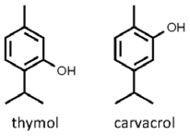 Thymus vulgaris
Thymus vulgaris
common thyme • garden thyme
Back to “Culinary herbs: thyme (Thymus vulgaris)*”
Thymus vulgaris L. (Lamiaceae); tiemie (Afrikaans); thym (French); Gartenthymian (German); timo (Italian); tomillo (Spanish)
DESCRIPTION Thyme leaves are very small (about 6 mm / ¼ in. long), dark green above, pale below and typically with the margins rolled in. They have a sharp, warm and spicy taste and a strong aromatic odour.
THE PLANT A perennial shrublet with slender stems, leaves in opposite pairs and tiny pale mauve flowers (rarely white or purple). Several hundred species and cultivars are grown as culinary herbs and ornamental plants. Amongst the best known are lemon thyme (T. ×citriodora, a hybrid between T. pulegioides and T. vulgaris), wild thyme (T. serpyllum), caraway thyme (T. herba-barona), Pennsylvanian Dutch thyme (T. pulegioides) and Spanish thyme (T. zygis).1 Less well known are Ethiopian thyme or tosign (T. schimperi) and Mongolian thyme or di jiao ye (T. mongolicus). Lemon thyme is usually a smaller, more spreading plant with rounded leaves (often variegated) and a distinct lemon smell. Wild thyme and Mongolian thyme are the only species used to any extent in East Asia.
ORIGIN Western Mediterranean to southeastern Italy.1 The use of thyme dates back to ancient Egypt, Greece and Rome. “The smell of thyme” is a Greek compliment, implying courage. Thyme has become one of the most important of all culinary herbs.2
CULTIVATION Plants are almost invariably propagated from cuttings or by division, in order to retain the characteristics of the cultivar or clone. Seeds are used in large-scale commercial cultivation. Thyme prefers full sun and should be grown in poor, slightly alkaline soil. Pruning after flowering encourages new growth.
HARVESTING Leafy twigs are picked at any time for use in the kitchen. The commercial dried herb is obtained by cutting and drying the stems until all the leaves have dropped off.
CULINARY USES Thyme is one of the essential culinary herbs of Western and Middle Eastern cuisines. Dried spice herb mixtures sold in supermarkets usually include thyme. It is an important ingredient of all meat dishes, including stuffings, sausages, poultry and fish.2 Thyme is added to soups, stews, lentils, scrambled eggs, tomato dishes and salads.2 Together with parsley, bay leaves and rosemary, it is tied into the traditional bouquet garni that can easily be removed after the sauce or stock has been flavoured. It is used to flavour Benedictine and other liqueurs. Wild thyme (serpolet in French, farigoule in Provençal) is typical of mutton, rabbit and trout dishes in the south of France.2 Lemon thyme is less pungent and adds a citrus flavour to veal, chicken, potatoes and seafood.
FLAVOUR COMPOUNDS The essential oil of common thyme (and several other species) is usually dominated by two phenols, thymol and carvacrol.3,4 These two compounds also give thyme its characteristic aroma.5

NOTES Thymol and carvacrol are antiseptic and have many medicinal uses.
1. Mabberley, D.J. 2008. Mabberley’s plant-book (3rd ed.). Cambridge University Press, Cambridge.
2. Larousse. 1999. The concise Larousse gastronomique. Hamlyn, London.
3. Farrel, K.T. 1999. Spices, condiments and seasonings. Aspen Publishers, Gaithersburg, USA.
4. Harborne, J.B., Baxter, H. 2001. Chemical dictionary of economic plants. Wiley, New York.
5. Díaz-Maroto, M.C., Díaz-Maroto Hidalgo, I.J., Sánchez-Palomo, E., Pérez-Coello, M.S. 2005. Volatile components and key odorants of fennel (Foeniculum vulgare Mill.) and thyme (Thymus vulgaris L.) oil extracts obtained by simultaneous distillation-extraction and supercritical fluid extraction. Journal of Agricultural and Food Chemistry 53: 5385–5389.